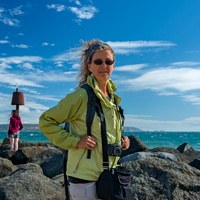Research Interests:
ABSTRACT In the last few years, intense blooms of the toxic benthic dinoflagellate Ostreopsis cf. ovata have been a recurrent phenomenon along several Mediterranean coasts during summer. Blooms are associated with noxious effect for... more
ABSTRACT In the last few years, intense blooms of the toxic benthic dinoflagellate Ostreopsis cf. ovata have been a recurrent phenomenon along several Mediterranean coasts during summer. Blooms are associated with noxious effect for humans and death of benthic invertebrates. Monitoring activities on the Conero Riviera (N Adriatic Sea) highlighted that O. cf. ovata colonizes several substrata, such as rocky bottom, pebbles, macrophytes, and invertebrates (molluscs, hydrozoans, echinoderms). The highest abundances of O. cf. ovata (106 cells / gram of fresh weight, i.e. 105 cells / square cm) were recorded at the end of summer, with significantly higher abundances on abiotic substrata than on macrophytes, suggesting that allelopathic interactions between epibionts and their host may occur. This study investigated the interactions between epiphytic O. cf. ovata and macroalgal hosts under experimental conditions. Macroalgae were chosen among the most common species in the Conero Riviera, Dictyota dichotoma (brown algae), Rhodymenia pseudopalmata (red algae) and Ulva rigida (green algae). Three different experiments were set up: O. cf. ovata was incubated (i) with fresh macroalgal tissues, (ii) with filtered culture media in which macroalgae were previously grown, and (iii) with dry macroalgal powder added at different concentrations. The results of coexistence assays showed that the growth of O. cf. ovata was inhibited by fresh tissue (U. rigida and D. dichotoma), by filtered culture media (D. dichotoma) and by dry macroalgal powder (all species). D. dichotoma had the highest inhibiting effect, causing growth decrease of O. cf. ovata under all the experimental conditions tested. Exposed cultures showed the presence of cysts.
Research Interests:
During 2004 an artificial barrier area has been sampled monthly to investigate the seasonal cycle of phytoplankton assemblages and estimate the downward flux of dinoflagellate cysts by the deployment of a sediment trap. Phytoplankton... more
During 2004 an artificial barrier area has been sampled monthly to investigate the seasonal cycle of phytoplankton assemblages and estimate the downward flux of dinoflagellate cysts by the deployment of a sediment trap. Phytoplankton polpulations showed a regular annual cycle with a spring bloom of Ceratau-lina pelagica. Calcareous walled cysts represented the most abundant morphotype and cyst fluxes showed a good relation with the organic fraction of the settling particles. A few HAB species have been detected in the water column, but in low abundances. Cysts of Lingulodinium polyedrum have been detected. Introduzione Il lavoro, svolto nell'ambito del Programma per la tutela ambientale della Regione del Veneto "Intervento 72 – Campo sperimentale in mare", coordinato dall'Osservatorio Alto Adriatico di ARPAV, ha lo scopo di studiare i popola-menti fitoplanctonici, da un punto di vista sia quantitativo (densità cellulare e numero di specie) sia qualitativo (dinamica...
Research Interests:
Research Interests:
Research Interests:
Research Interests:
Research Interests:
Research Interests:
Harmful benthic microalgae blooms represent an emergent phenomenon in temperate zones, causing health, ecological and economic concern. The main goal of this work was to compile records of Ostreopsis at large temporal and spatial scales,... more
Harmful benthic microalgae blooms represent an emergent phenomenon in temperate zones, causing health, ecological and economic concern. The main goal of this work was to compile records of Ostreopsis at large temporal and spatial scales, in order to study the relationship between cell abundances, the periodicity and intensity of the blooms and the role of sea water temperature in 14 Spanish, French, Monegasque and Italian sites located along the northern limits of the Mediterranean Sea. General trends were observed in the two considered basins: the north-western Mediterranean Sea, in which higher cell abundances were mostly recorded in mid-summer (end of July), and the northern Adriatic Sea where they occur in early fall (end of September). The sea-water temperature does not seem to be a primary driver, and the maximal abundance periods were site and year specific. Such results represent an important step in the understanding of harmful benthic microalgae blooms in temperate areas, and provide a good base for policy makers and managers in the attempt to monitor and forecast benthic harmful microalgae blooms.
